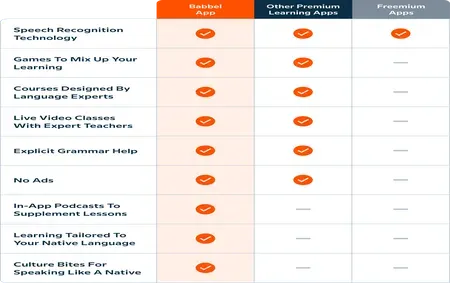The best 10 Language Learning Apps
Language learning apps have revolutionized the way individuals acquire new languages, making it more accessible and engaging than ever before. These digital tools offer a variety of features, including interactive lessons, quizzes, and social components, which cater to different learning styles and preferences. Users can learn at their own pace, making language acquisition more convenient and tailored to their lifestyles.
The rise of language learning apps can be attributed to their user-friendly interfaces and the incorporation of gamification elements, which keep learners motivated and invested in their progress. Popular apps like Duolingo, Babbel, and Rosetta Stone provide structured courses that cover vocabulary, grammar, and pronunciation, often using spaced repetition to enhance retention. Many of these platforms also include speech recognition technology, allowing users to practice their speaking skills and receive instant feedback. Furthermore, the community aspect of these apps enables learners to connect with native speakers and fellow learners, fostering a collaborative environment. As technology continues to evolve, features like augmented reality and artificial intelligence are being integrated into language learning apps, promising even more immersive experiences. Overall, language learning apps have democratized language education, allowing learners from diverse backgrounds to explore new cultures and enhance their communication skills, paving the way for a more interconnected world.

 View All
View AllDuolingo - Duolingo features gamified lessons, personalized learning paths, interactive exercises, and a vibrant community for language practice.

 View All
View AllBabbel - Babbel offers interactive lessons, speech recognition technology, personalized learning paths, and a focus on real-life conversation skills.

 View All
View AllRosetta Stone - The most attractive Rosetta Stone features bilingual inscriptions, intricate carvings, and historical significance in deciphering ancient languages.

 View All
View AllMemrise - Memrise offers engaging language courses, spaced repetition, user-generated content, interactive games, and real-world phrase usage.

 View All
View AllBusuu - Busuu offers interactive language courses, personalized feedback from native speakers, and a community for practice and support.

 View All
View AllPimsleur - Pimsleur offers audio-based language learning with immersive conversation practice, spaced repetition, and convenient mobile access for effective retention.

 View All
View AllTandem - The most attractive Tandem features lightweight aluminum frame, comfortable seating, smooth gear shifting, and excellent stability for two riders.

 View All
View AllDrops - Vibrant colors, unique designs, limited editions, high-quality materials, exclusive collaborations, and eco-friendly production methods.

 View All
View AllHelloTalk - HelloTalk connects language learners through text, voice, and video chats, with translation tools and a global community.

 View All
View AllBeelinguapp - Beelinguapp offers bilingual reading with audio narration, customizable text size, and a diverse library of stories.
The best 10 Language Learning Apps
1.
Duolingo
Pros
Interactive language learning
gamified experience
personalized lessons
flexible schedule
diverse language options
community support
progress tracking
bite-sized sessions
boosts confidence
enhances cultural understanding.
Cons
Limited depth in grammar
repetitive exercises
lack of speaking practice
insufficient context for vocabulary
not suitable for advanced learners
reliance on internet access
potential for incorrect answers.
2.
Babbel
Pros
Interactive lessons
personalized learning paths
speech recognition technology
diverse language options
cultural insights
progress tracking
mobile accessibility
engaging content
real-life conversation practice
flexible learning pace.
Cons
Limited language options
subscription cost
less focus on speaking skills
lack of cultural context
repetitive exercises
potential for outdated content
no live interaction
limited grammar explanations.
3.
Rosetta Stone
Pros
Immersive language learning
flexible pacing
interactive exercises
speech recognition technology
diverse languages
cultural context integration
user-friendly interface
progress tracking
mobile access
engaging content.
Cons
High cost
limited grammar explanation
lack of speaking practice
repetitive exercises
no cultural context
not suitable for advanced learners
can be time-consuming
limited language options.
4.
Memrise
Pros
Engaging vocabulary practice
interactive learning methods
spaced repetition for retention
diverse language options
gamified experience
cultural insights
community support
customizable learning paths
mobile accessibility.
Cons
Limited depth in advanced topics
reliance on user-generated content
occasional inaccuracies
repetitive learning methods
less interaction with native speakers
subscription costs for full access.
5.
Busuu
Pros
Interactive language courses
personalized feedback
native speaker interactions
community support
flexible learning schedule
mobile accessibility
gamified lessons
cultural insights
progress tracking
diverse language options.
Cons
Limited free content
subscription costs can be high
lack of advanced grammar explanations
community corrections can be inconsistent
mobile app may have bugs
limited language options.
6.
Pimsleur
Pros
Improves pronunciation
enhances listening skills
builds vocabulary
encourages conversational fluency
boosts confidence
promotes retention
flexible learning pace
convenient audio format
accessible anytime
engaging cultural insights.
Cons
Limited vocabulary range
lacks grammar explanations
repetitive nature can be tedious
no reading or writing practice
expensive compared to other resources
audio-only format may not suit all learners.
7.
Tandem
Pros
Language exchange
cultural immersion
improved fluency
personalized learning
social connections
enhanced listening skills
real-life conversation practice
diverse perspectives
increased confidence
flexible scheduling.
Cons
Limited language proficiency
potential miscommunication
reliance on partner's availability
varying commitment levels
possible frustration with pacing
cultural misunderstandings
lack of structured learning
uneven practice opportunities.
8.
Drops
Pros
Enhanced focus
improved memory retention
stress relief
increased creativity
efficient learning methods
engaging experience
personalized content
community support
regular progress tracking
fun gamified approach.
Cons
Potential loss of items
damage to property
safety hazards
inconvenience
financial cost
emotional distress
disruption of plans
decreased productivity
risk of injury
wasted time.
9.
HelloTalk
Pros
Language exchange with native speakers
real-time messaging
voice and video calls
cultural exchange opportunities
personalized learning
community support
language correction features
engaging language challenges.
Cons
Limited free features
potential language barriers
inconsistent quality of language partners
privacy concerns
intrusive ads
time zone differences
and occasional technical glitches.
10.
Beelinguapp
Pros
Improves language skills
enhances vocabulary
boosts comprehension
offers bilingual reading
encourages cultural understanding
provides audio support
tracks progress
user-friendly interface
diverse content selection.
Cons
Limited language options
occasional translation inaccuracies
requires an internet connection
user interface can be cluttered
some content may not be engaging
lacks advanced features for serious learners.